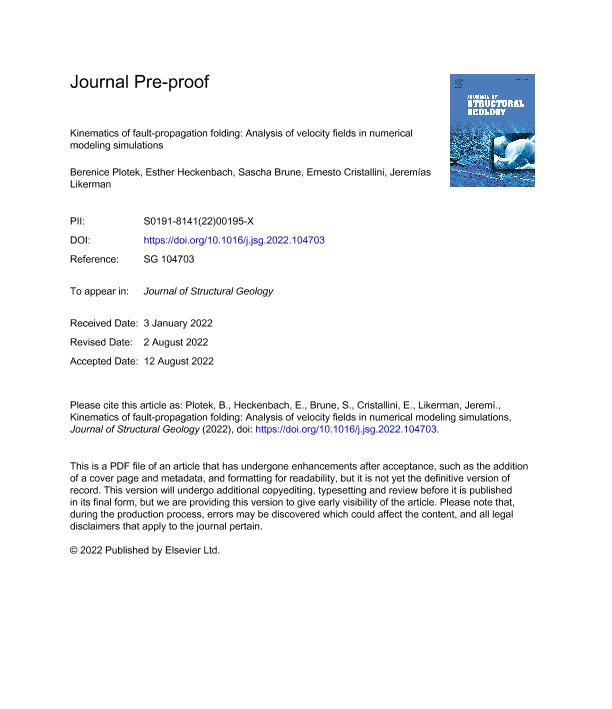Mostrar el registro sencillo del ítem
dc.contributor.author
Plotek, Berenice Lia

dc.contributor.author
Heckenbach, Esther
dc.contributor.author
Brune, Sascha
dc.contributor.author
Cristallini, Ernesto Osvaldo

dc.contributor.author
Likerman, Jeremias

dc.date.available
2023-07-10T14:28:38Z
dc.date.issued
2022-09
dc.identifier.citation
Plotek, Berenice Lia; Heckenbach, Esther; Brune, Sascha; Cristallini, Ernesto Osvaldo; Likerman, Jeremias; Kinematics of fault-propagation folding: Analysis of velocity fields in numerical modeling simulations; Pergamon-Elsevier Science Ltd; Journal Of Structural Geology; 162; 9-2022; 1-14
dc.identifier.issn
0191-8141
dc.identifier.uri
http://hdl.handle.net/11336/202953
dc.description.abstract
Fault-propagation folding occurs when a shallow fold is created by an underlying propagating thrust fault. These structures are common features of fold and thrust belts and hold key economic relevance as groundwater or hydrocarbon reservoirs. Reconstructing a fault-propagation fold is commonly done by means of the trishear model of the forelimb, a theoretical approach that assumes simplistic rheological rock properties. Here we present a series of numerical models that elucidate the kinematics of fault-propagation folding within an anisotropic sedimentary cover using complex visco-elasto-plastic rheologies. We explore the influence of different parameters like cohesion, angle of internal friction, and viscosity during folding and compare the velocity field with results from the purely kinematic trishear model. In the trishear paradigm, fault-propagation folding features a triangular shear zone ahead of the fault tip whose width is defined by the apical angle that in practice serves as a freely tunable fitting parameter. In agreement with this framework, a triangular zone of concentrated strain forms in all numerical models. We use our models to relate the apical angle to the rheological properties of the modeled sedimentary layers. In purely visco-plastic models, the geometry of the forelimb obtained can be approximated using a trishear kinematic model with high apical angles ranging between 60° and 70°. However, additionally accounting for elastic deformation produces a significant change in the geometry of the beds that require lower apical angles (25°) for trishear kinematics. We conclude that all analyzed numerical models can be represented by applying the theoretical trishear model, whereby folds involving salt layers require high apical angle values while more competent sedimentary rocks need lower values.
dc.format
application/pdf
dc.language.iso
eng
dc.publisher
Pergamon-Elsevier Science Ltd

dc.rights
info:eu-repo/semantics/openAccess
dc.rights.uri
https://creativecommons.org/licenses/by-nc-sa/2.5/ar/
dc.subject
FAULT-PROPAGATION FOLDS
dc.subject
FAULT-RELATED FOLDING
dc.subject
NUMERICAL MODELING
dc.subject
TRISHEAR KINEMATICS
dc.subject
VELOCITY FIELDS
dc.subject.classification
Geología

dc.subject.classification
Ciencias de la Tierra y relacionadas con el Medio Ambiente

dc.subject.classification
CIENCIAS NATURALES Y EXACTAS

dc.title
Kinematics of fault-propagation folding: Analysis of velocity fields in numerical modeling simulations
dc.type
info:eu-repo/semantics/article
dc.type
info:ar-repo/semantics/artículo
dc.type
info:eu-repo/semantics/publishedVersion
dc.date.updated
2023-07-06T14:21:59Z
dc.journal.volume
162
dc.journal.pagination
1-14
dc.journal.pais
Países Bajos

dc.journal.ciudad
Amsterdam
dc.description.fil
Fil: Plotek, Berenice Lia. Consejo Nacional de Investigaciones Científicas y Técnicas. Oficina de Coordinación Administrativa Ciudad Universitaria. Instituto de Estudios Andinos "Don Pablo Groeber". Universidad de Buenos Aires. Facultad de Ciencias Exactas y Naturales. Instituto de Estudios Andinos "Don Pablo Groeber"; Argentina
dc.description.fil
Fil: Heckenbach, Esther. Universitat Potsdam; Alemania
dc.description.fil
Fil: Brune, Sascha. German Research Centre for Geosciences; Alemania
dc.description.fil
Fil: Cristallini, Ernesto Osvaldo. Consejo Nacional de Investigaciones Científicas y Técnicas. Oficina de Coordinación Administrativa Ciudad Universitaria. Instituto de Estudios Andinos "Don Pablo Groeber". Universidad de Buenos Aires. Facultad de Ciencias Exactas y Naturales. Instituto de Estudios Andinos "Don Pablo Groeber"; Argentina
dc.description.fil
Fil: Likerman, Jeremias. Consejo Nacional de Investigaciones Científicas y Técnicas. Oficina de Coordinación Administrativa Ciudad Universitaria. Instituto de Estudios Andinos "Don Pablo Groeber". Universidad de Buenos Aires. Facultad de Ciencias Exactas y Naturales. Instituto de Estudios Andinos "Don Pablo Groeber"; Argentina
dc.journal.title
Journal Of Structural Geology

dc.relation.alternativeid
info:eu-repo/semantics/altIdentifier/url/https://linkinghub.elsevier.com/retrieve/pii/S019181412200195X
dc.relation.alternativeid
info:eu-repo/semantics/altIdentifier/doi/http://dx.doi.org/10.1016/j.jsg.2022.104703
Archivos asociados
